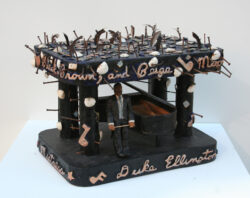Willie Birch
Artist Willie Birch's work emphasizes the continuing relevance of African heritage in New Orleans, the vernacular vitality of its African American community, and the city's dark legacy of racial oppression.

Courtesy of Arthur Roger Gallery
For the Duke. Birch, Willie (Artist)
Deeply dedicated to his hometown of New Orleans, Willie Birch is one of Louisiana’s most significant living African American artists. Working in a distinctive figural style, his art encompasses two- and three-dimensional forms, including papier-mâché, acrylic paintings, and charcoal drawings. His work emphasizes the continuing relevance of African heritage in New Orleans, the vernacular vitality of its African American community, and the city’s dark legacy of racial oppression.
Birch was born in New Orleans in 1942, auspiciously on Thanksgiving night, during holiday dinner at his aunt’s restaurant. He grew up in the Magnolia housing projects of New Orleans, and by age eleven was recognized for his drawing talent. Coming of age in a segregated city left a strong impression on Birch’s development as an artist—he recalls visiting the New Orleans Museum of Art as a sixth-grader and gathering the impression that “this is not for you.” In 1960, Birch briefly attended Southern University in Baton Rouge, before transferring to Southern University in New Orleans (SUNO), where he studied under sculptor Jack Jordan. In 1961 he joined the Congress of Racial Equality (CORE) and participated in a civil rights sit-in demonstration at a Woolworths Department Store on Canal Street. His mother thereafter gave him the ultimatum to stop protesting or move out. From 1962 to 1965 Birch served in the United States Air Force and in 1965 was able to return to SUNO and continue his studies under the G.I. Bill. He received his BA in painting in 1969.
After moving to Baltimore, Maryland, to work as an assistant manager in various Kresge department stores, in 1971 Birch enrolled under full scholarship at the Maryland Institute College of Art and received his MFA in 1973. He began visiting New York City (eventually moving there in 1975). During his time he studied African art, and was exposed to seminal texts such as Robert Farris Thompson’s Flash of the Spirit, which explores the influence of Yoruba culture in the Americas. In New York, Birch developed friendships with a number of now prominent African American artists, including David Hammons, Faith Ringold, and Dawoud Bey. While in New York, Birch received a number of artist-in-residence appointments, including at the Studio Museum in Harlem and the Henry Street Settlement. He also received a number of prominent mural commissions, including a mural for the Public Art Fund.
In 1984 Birch was appointed adjunct professor at Touro College in the Bronx. That same year he began working in the medium of papier-mâché, having been inspired by the papier-mâché crucifix on view in St. Louis Cathedral in New Orleans during the 1984 World’s Fair. The following year Birch received a National Endowment for the Arts fellowship for sculpture, which he used to travel to Egypt.
In 1989 Birch received a grant from the New York State Council on the Arts to make a sculpture about slavery, an award that ultimately led to his decision to move back to New Orleans in early 1990s. Birch returned to his hometown to conduct research on slavery at the archives of the New Orleans Public Library. Through the mid-1990s he continued to create papier-mâché figures of African Americans and sculptures inspired by African designs. In the late 1990s his sculptural works shifted into two-dimensional large-scale portraits of people in his community, particularly those living in New Orleans’s Seventh Ward. The idea he said “was to make these people we call African Americans larger than life so that the viewer can confront them as equals.”
In 2000 Birch decided to abandon color in his drawings, opting instead to work in gray scale. The result allowed for a degree of abstraction and “visual jazz” in the drawings’ distribution of light and dark. The subject matter meanwhile remained true to Birch’s New Orleans roots, depicting second lines, social aid and pleasure clubs, and neighborhood characters sitting on stoops. The work also probed the ongoing problem of violence, particularly among young men in the community. Well known as a mentor figure in his neighborhood, Birch became a cofounder (along with artist Ron Bechet) of The Porch Seventh Ward Cultural Organization, a multidisciplinary arts and community center founded post-Katrina for a largely African American neighborhood in New Orleans.
After exhibiting his large-scale black-and-white drawings at the New Orleans Museum of Art during U.S. Biennial Prospect.1 in 2008, Birch’s work became more introspective, focusing on the plant and insect life in his backyard. His interest in the fragility of grass, wildflowers, and crawfish mounds dovetails with his interest in humanity’s relationship to nature. His most recent artistic experiment has involved converting these crawfish mounds into sculptural forms, both in papier-mâché and potentially in large-scale bronze.
